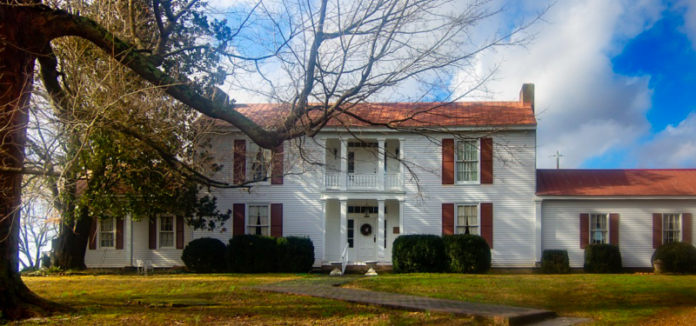Still a private residence, Cornsilk, a historic home located near Cross Plains, Tennessee, was once the home of Southern “Agrarian” writer Andrew Nelson Lytle. Lytle was an actor, writer, editor, critic, teacher, and a chronicler of the changes in farm living after World War I. He primarily wrote between the 1920s and 1970s.
The house was originally built by Thomas Stringer between 1850 and 1874. Located on Highland Road, it is designed in the Tennessee Vernacular architectural style, but is unique with its two-story recessed front porch.
Vernacular architecture is dictated by the local materials available, and it reflects the traditions and culture of its surroundings. These homes were not usually designed by a formally schooled architect, but instead relied on the skill of local builders. The home’s tie to the land was what probably attracted Lytle.
This home stayed in the Stringer family until 1939 when Lytle bought it from Stringer’s daughter, Mary Jane “Jennie” Stringer Crocker, shortly before she died. Lytle and his wife, Edna Barker, lived there off and on until 1957. He named it “Cornsilk” after his family’s farm in Alabama, which was lost to him in a legal battle over mortgage rights in 1936. At the time, the home in Cross Plains sat on a 330-acre farm.
It was during his time at this home that he wrote four of his works: “At the Moon’s Inn,” “A Name for Evil,” “The Velvet Horn” and “A Novel, a Novella, and Four Stories.” “The Velvet Horn,” a dense and complex story of a boy’s growth into manhood while facing his family’s deepest secrets, was considered his best. His writing style has been compared to that of James Joyce, who wrote a generation before him, or William Faulkner. Both the setting and the story is fecund, with an underlying theme of sensuality and man’s deep connection with nature. It is a theme that drove his life’s work. The book was a National Book Award finalist in 1958.
Never one to stay in one place for very long, during the period of time that he owned Cornsilk, Lytle also lived in a log cabin in Sewanee and built a home in Florida. He taught at Southwestern Presbyterian University in Memphis, now Rhodes College; the Iowa Writers Workshop; Kenyon College in Kentucky; University of the South in Sewanee; and founded the writing program at the University of Florida, where he was resident from 1948 to 1961. He retired from teaching in 1973.
Lytle was a graduate of Vanderbilt University, where he became involved with the Southern Agrarian literary movement through his professors, Donald Davidson and John Crowe Ransom. He contributed to the organization’s best-known work, “I’ll Take My Stand,” which was a sort of manifesto against industrialization and a call to return to a simpler, pre-World War I farm life.
He contributed an essay called, “The Hind Tit.” It discussed the economic disadvantages experienced by small farmers in a modern economy. It was a topic he knew well, being a small farmer himself.
Overall, the group was for preserving small-town life and against a strong central authority. While Lytle didn’t agree with all that was said in the work, he kept himself tied to the land most of his life, being a farmer and a writer until he eventually sold both “Cornsilk” farms, having eventually inherited the one in Alabama from his father.
The Agrarian group included famous poets Robert Penn Warren and Alan Tate. Tate became a good friend and invited him to visit. Staying in the South most of his life, Lytle did take Tate up on his offer and spent his early years in New York and parts of the Northeastern United States. He acted, wrote a play, did literary criticism and studied at Yale University.
Eventually, he returned to the South and began work on a biography of the now reviled Nathan Bedford Forrest. This was his first significant work. He was a prolific writer of both fiction and non-fiction, as well as literary criticism. His critiques sharpened the works of authors like Caroline Gordon, Flannery O’Connor, Peter Taylor, Katherine Anne Porter, and Cleanth Brooks, many of whom were his students. And his biography of Forrest inspired Shelby Foote to write his history of the Civil War decades later.
Today, his works are lesser known, but he had a profound effect on Southern literature during its Renaissance from the 1920s until the 1950s. And his blood runs deep here. He is related to William Lytle, one of the founders of Murfreesboro, Tennessee, where he was born. He was raised between Murfreesboro and the family farm in Alabama.
He spent his final years in Sewanee in a cabin where he was an enigmatic blend of the quintessential Southern gentleman farmer and the modern sophisticate. He would, according to the Tennessee Encyclopedia, “offer a salon featuring bourbon in sterling silver cups and his own ruminations, ranging from theological musings to backwoods tall tales, from the proper use of olive oil to the decline and fall of the Episcopal Church. By turns formal and earthy, he fascinated generations of undergraduates and transfixed aspiring writers and journalists who, in search of the authentic South, gathered around him, dining and listening–always listening to his incomparable, subtly sophisticated voice. Still a fierce defender of Agrarianism…he would nevertheless dress in Brooks Brothers shirts and, for a time in the 1980s, drive a black Mercedes around the mountain.”
For more information about Lytle and his work, read the Tennessee Encyclopedia, the Encyclopedia of Alabama, and his collected papers at Vanderbilt University.



























